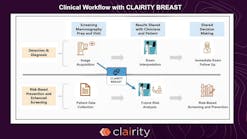Laboratories provide crucial data in in the diagnosis and treatment of diseases. That is why industry leaders think lab managers should be involved in plotting their institution’s transition from payment structures based on the volume of services delivered to those based on patient outcomes.
Wilkerson and Kaul are not alone. The Project Santa Fe Foundation, where Wilkerson and Kaul are board members, was launched in 2016 to promote the role and value of laboratories – and their data – in the healthcare industry’s transition to reimbursement based on outcomes.
“It is really about inserting our managers and our pathologists into the care team – just as pharmacy has become an integral part of the care team, particularly in the inpatient setting,” Wilkerson said.
In an article in Academic Pathology, the group pointed to the role lab tests play in both inpatient and outpatient treatments. They argued that labs can play a central role in the transition to value-based care through such activities as promoting appropriate test utilization, interpreting test results and guiding subsequent clinical actions, and optimizing the use of test data and pathology reports in analytics.1
They explain this transition in the lab’s role within the health system as moving from Clinical Lab 1.0 to Clinical Lab 2.0 – or from reactive to proactive.
Michelle Del Guercio, Vice President of Marketing, Sunquest Information Systems, added that, “This also will help position the lab to be seen as a strategic asset, align it to receive funding as a part of these initiatives, and continue to increase its value to the organization.”
How should lab managers become involved?
The first step is to understand what the health system’s key strategic initiatives are to drive the transition to value-based care. These initiatives often are part of population health, which involves improving the health outcomes for groups of similar patients, such as those with diabetes, and chronic disease management, which involves actively monitoring and educating individual patients to help them manage their health.
The role of data
Second, they should recognize that “the bulk of the medical record data (70 percent or so) is coming from the laboratory, and these are all quantitative results that can be used to get a really good sense of population health and also on an individual basis,” Suren Avunjian, CEO of LigoLab Information System, said, citing an often-quoted statistic.
Del Guercio said, “Supporting population health requires sophisticated reporting, connectivity and systems integration. This is especially true for complex cases that require extensive lab testing, such as congestive heart failure, pneumonia, acute cardiac disease, infections and chronic kidney disease.”
In addition to patient-level data, lab results, either alone or combined with other patient data from other sources, provide insights into how to improve outcomes at the population level.
For example, longitudinal lab results are important ingredients in electronic models that risk-stratify patients with chronic conditions. Based on the output from the models, clinicians know which of their patients need attention, such as from a care coordinator, to help prevent costly hospital stays and ED visits.
“There are incredible benefits from harnessing the patient data produced not only in the lab but throughout the hospital,” said David Metrena, Vice President, Healthcare, at LabVantage Solutions, adding, “Being able to analyze and model data under different circumstances, or do some predictive analytics, enables a much broader view of the population being served.”
Interoperability challenges
However, problems with sharing data between laboratory information systems (LIS) and electronic health records (EHR) can impede the data aggregation and analysis necessary to support population health and disease management efforts.
“In an ideal scenario, there is EHR/LIS integration, and all that data, including claims data, is within a data warehouse where it can be compiled and accessed for any type of query needed to support population health initiatives. But this scenario is certainly not the norm,” said Kim Futrell, MT(ASCP), MSHI, Products Marketing Manager at Orchard Software.
The issues often are caused by disparities in the way different systems manage patient identification, test codes, diagnosis codes and other data elements.
Issues with interoperability can be magnified at health systems that have more than one EHR in addition to the LIS and/or other sources of patient data, such as wireless patient-monitors.
In those instances, it may make more sense to stream the data from the EHRs, LIS and other sources into a separate data warehouse for analytics, Futrell said.
Widespread industry adoption of standardized programming interfaces, or APIs, can help remedy interoperability problems. One prominent standard is Fast Healthcare Interoperability Resources (FHIR) framework, which was developed by HL-7 International, a nonprofit standards-developing organization. In a 2019 blog post, the Office of the National Coordinator for Health Information Technology (ONC) said about 32 percent of EHR vendors were incorporating FHIR into their platforms; however, the 10 largest EHR vendors all reported using FHIR.2
And in final rules released earlier this year, ONC and the Centers for Medicare & Medicaid Services (CMS) require vendors to use standardized APIs for patient data, saying the ultimate goal is for patients to have easy access to their electronic medical information.
Geisinger’s population health efforts
Issues with data interoperability have not prevented Geisinger’s laboratory managers from participating in numerous value-based care projects to improve clinical outcomes.
One example is the inpatient sepsis bundle. In 2014, Geisinger created a multidisciplinary team, including lab, to improve sepsis diagnosis for patients in the emergency department. As a result of that effort, Geisinger decided to move the testing and analysis of blood cultures to the local hospital lab, instead of the integrated health system’s core laboratory.
Now, all hospitals and micro-hospitals (freestanding emergency departments with a small number of beds) process the blood samples. “Most of our laboratories have a pneumatic tube system that delivers the bottles from the emergency room. If they don’t, there are couriers,” explained Donna Wolk, MHA, PhD, [ABMM] Division Director of Molecular and Microbial Diagnostics in Laboratory Medicine at Geisinger.
The blood samples are incubated on-site. For positive cultures, gram stains and multiplex PCR to identify the microorganism also are done locally. Antimicrobial susceptibility testing is then completed at the core lab.
With this process, Geisinger has reduced the time required to identify an organism and determine what the appropriate antibiotic is by about 10 hours and has a positive culture grown within seven hours. Noting that blood samples are sometimes shipped long distances, Wolk said those turnaround times are “unheard of if you are already transporting the bottle six or seven hours. You have missed the early window to get the physician that extra information to tailor antimicrobials appropriately.”
But those time savings will not improve patient outcomes unless ICU providers use the information to prescribe the appropriate antibiotic. That is why Geisinger’s lab employees send an encrypted text message to the provider with the organism’s identification, Wolk said.
Expanding to outpatient operations
Geisinger also has expanded its sepsis work to the outpatient arena. The goal is to develop a model to identify patients who are at risk of developing sepsis within two or three months. The long-term goal would be to incorporate the model into the EHR at the point of care, so that primary care providers can intervene to prevent patients’ health from deteriorating to the point that they develop sepsis.
That goal is not a reality at this point. Currently, a team at Geisinger is sifting through thousands of data points, such as test results and comorbidities, to determine the factors associated with risk for developing sepsis.
More recently, the lab has been involved in in efforts to improve patient care for anemia. “At any given time, somewhere around 10 or 15 percent of your population is anemic. It is a comorbidity of so many chronic diseases – COPD, congestive heart failure, and chronic renal disease,” Wilkerson said.
Geisinger reengineered the process so that physicians can order a CBC anemia reflex panel, instead of the CBC panel at one office visit followed by an anemia reflex plan at the next visit.
With the new process, the lab automatically runs tests to determine the root cause of anemia on samples that are positive. “That saves the patient a lot of work up and can save several months of time and unnecessary appointments getting to a diagnosis,” Wilkerson said.
The process has been pilot-tested at several locations and Geisinger is analyzing the data to quantify the results. Based on anecdotal reports alone, Wilkerson said that both patients and providers are happy with the streamlined process.
NorthShore’s efforts
Meanwhile, NorthShore University HealthSystem, located on Chicago’s suburban North Shore, also has been using lab data in innovative ways to help physicians diagnose and treat patients.
One example is an app called What’s Going Around? Updated nightly, the app displays a map with the rates of various infectious diseases and pediatric asthma in the health system’s local service area. Providers access the electronic program either by downloading the app to their mobile device or clicking on an icon on the home screen of the EHR.
In addition to asthma, the other diseases tracked in the app include influenza, strep, whooping cough and gastroenteritis.
“We used to very proudly publish our weekly rates of flu on our website, but it wasn’t in the hands of physicians when they needed it,” Kaul said. With the app, “We are taking the data and getting it out there for them. It has been quite useful.”
The members of Project Santa Fe also are collaborating on projects. For example, multiple organizations are involved in a pre- and post- intervention study to find out if the improvements Geisinger has logged in the time to identify a bacteria and appropriate antibiotic can be replicated at other institutions, Wolk said.
In summing up the lab industry’s role in value-based care and population health efforts, Wilkerson said, “We have to become stewards of that data. We have to learn how to manipulate that data, we have to learn how to manage that data, and we have to learn how to ask the right questions of that data.”
References:
- Crawford J, Shotorbani K. Improving American healthcare through Clinical Lab 2.0: a Project Santa Fe report. Acad Pathol. 2017. 18;4. doi: 10.1177/2374289517701067.
- Steven Posnack and Wes Barker. Heat wave: The U.S. is poised to catch FHIR in 2019. Office of the National Coordinator for Health Information Technology. October 2018. https://www.healthit.gov/buzz-blog/interoperability/heat-wave-the-u-s-is-poised-to-catch-fhir-in-2019. Accessed September 3, 2020.







